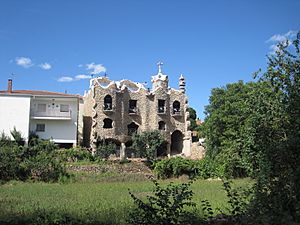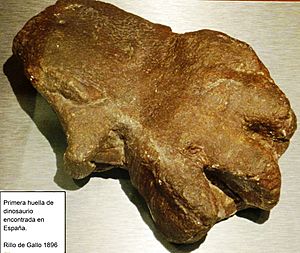Rillo de Gallo facts for kids
Quick facts for kids
Rillo de Gallo, Spain
|
||
|---|---|---|
 |
||
|
||
| Country | ||
| Autonomous community | Castile-La Mancha | |
| Province | Guadalajara | |
| Municipality | Rillo de Gallo | |
| Area | ||
| • Total | 25 km2 (10 sq mi) | |
| Population
(2018)
|
||
| • Total | 44 | |
| • Density | 1.76/km2 (4.56/sq mi) | |
| Time zone | UTC+1 (CET) | |
| • Summer (DST) | UTC+2 (CEST) | |
Rillo de Gallo is a small town, also called a municipality, located in the province of Guadalajara in Spain. This area is part of the Castile-La Mancha region. In 2018, about 44 people lived in Rillo de Gallo.
Contents
What Does the Town's Symbol Mean?
The official symbol, or heraldic shield, of Rillo de Gallo was approved in 1987. This shield is divided into three parts, each with a special meaning.
- The top left part shows a golden rooster on a blue background.
- The top right part has a simple elm tree on a gray background.
- At the bottom, you can see a silver axe on a blue background.
Where is Rillo de Gallo Located?
Rillo de Gallo is found high up, at about 1,055 meters (3,461 feet) above sea level. The highest point nearby is Loma de Matillas, which reaches 1,404 meters (4,606 feet).
Rivers and Borders
The town gets its name from the Gallo river, even though the river is a bit far from the main town area. However, it helps water the local lands. Other rivers like the Viejo River, the Herrería River, and the Arroyo Seco River also flow through this region.
Rillo de Gallo shares its borders with several other towns:
- To the north, it borders Pardos and Torrubia.
- To the south, it borders Corduente.
- To the east, it borders Rueda de la Sierra and Molina de Aragón.
- To the west, it borders Herrería.
What Can We Learn from the Rocks?
The area around Rillo de Gallo is very special for geology, which is the study of Earth's physical structure and substances. Scientists have even suggested it should be a "geosite" because of its unique rocks and landforms.
Ancient Fossils and Rock Layers
Many rock formations here contain fossils from the Permian and Triassic periods. These periods were millions of years ago! The fossils include well-preserved ancient plants, pollen, and even footprints of sea animals.
Scientists have also found that this region has the only complete set of rock layers in the Iberian Peninsula from the Permian and Triassic times. These layers show how a large river system once flowed here, carrying sediment like gravel and sand.
A Special Road for Geologists
The road from Rillo de Gallo to Pardos, which goes along the Hoz del Río Gallo ravine, is considered a "Global Geosite." This means it's a very important place for understanding Earth's history, especially how the supercontinent Pangea broke apart.
A Glimpse into Rillo de Gallo's Past
Some old stories say that the ancient city of Molina, once called "Manlia," was built by the Romans right next to Rillo de Gallo. However, Manlia was actually a major city for the Celtiberians, an ancient group of people in Spain, long before the Romans.
Molina la Vieja: An Old Settlement
There's an older area within Rillo de Gallo called Molina la Vieja, which means "Old Molina." You can still see parts of old walls and rocks there. It's about one kilometer northeast of the current town.
The famous Spanish hero El Cid (who lived from 1048 to 1099) likely passed through Molina la Vieja. This was because the current city of Molina was built later by Christian kings. Old writings mention that many buildings and a castle once stood in Molina la Vieja. It's even said that the Moors, who used to live there, left hidden treasures when they had to leave!
The First Dinosaur Footprint in Spain
Rillo de Gallo is famous for a very exciting discovery: the first dinosaur footprint ever found in Spain! This happened in 1896 when a local person found a "stone foot of a bug." Experts later realized it was a fossilized leg of a large animal, identified as a Chirotherium.
This amazing footprint is now kept at the National Museum of Natural Sciences in Madrid. It's a great example of the ancient reptiles that once roamed this area.
Important Buildings and Art
Rillo de Gallo has some interesting places to visit that show its history and culture.
- The parochial church is a small building with a bell-gable on the west side. It has a simple round door on the south, which reminds us of its old medieval beginnings.
- The house of the marquises of Embid has a traditional design. It features a beautiful Baroque shield above its door. In the town square, there's a fountain dedicated to Calixto Rodríguez.
- The Capricho Rillano is a unique building built by Juan Antonio Martínez. It's a modernist style house, meaning it has a very modern and artistic design. It looks a bit like the work of the famous architect Antoni Gaudí. The house is made of stone and includes metalwork and colorful broken tile mosaics, similar to Gaudí's style. One of its most striking features is a large serpent that seems to fall from the roof, going all the way down the building. This refers to an old legend from the 17th century about a giant snake in the nearby Villacabras area.
- El Abrigo del Llano (Rillo I and Rillo II) are two sites with ancient cave paintings. These paintings are so important that UNESCO declared them World Heritage Sites in 1998. They are the only cave paintings of this type in the province of Guadalajara.
Fun Traditions and Food
Rillo de Gallo has its own special customs and delicious foods.
Local Celebrations
The town celebrates several festivals in September. On September 8th, 9th, and 10th, they celebrate the Nativity of the Virgin Mary, the Fiestecilla, and the Abuela. Historically, these festivals were not held in August.
Tasty Local Foods
The municipality is known for its tasty local foods, especially its delicacies like sausages. The blood sausages and chorizo from Rillo de Gallo are particularly famous.
See also
 In Spanish: Rillo de Gallo para niños
In Spanish: Rillo de Gallo para niños



